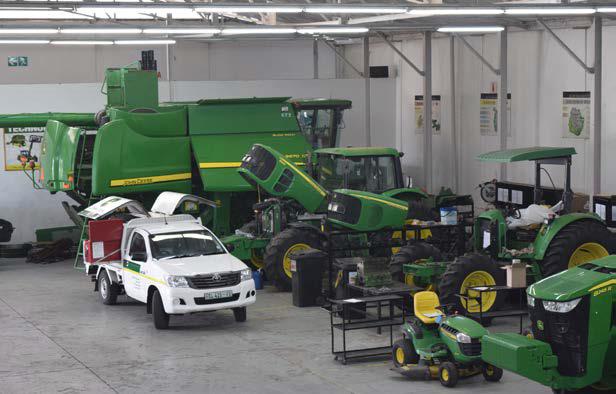Agricultural equipment suppliers know that more income is made from the maintenance of agricultural machinery and accessories than from the actual sale of the vehicles, equipment, and accessories.
Financial models for mechanical parts have moved over the years from being about making something that lasts forever, needing minimal maintenance and reparation, to making technology that gives healthy balance sheets to the suppliers whilst simultaneously satisfying farmers’ need to advance technologically.
This strategy by agricultural firms stems out of the need for rapid Returns On Investments (ROI) for their shareholders, and also out of the inevitable redundancy brought on by technological advancements.
What may seem like a lifetime changing invention in today’s rapidly changing world ceases to be so after less than half a decade, therefore focussing on profits within the shortest period of time makes sense. Thus, maintenance and repair strategies must also be technological savvy and dynamic.

Maintenance procedures can be categorised into reactive/unplanned and proactive/planned actions. These can be broken down further:
1. Reactive/unplanned
1.1 Corrective
1.2. Emergency maintenance
2. Proactive/planned maintenance
2.1. Preventative
2.1.1.Constant interval
2.1.2.Age-based
2.1.3.Imperfect maintenance
2.2. Predictive
2.2.1.Reliability-centred
2.2.2.Condition-based
Corrective maintenance is realised when a flaw has been identified on a piece of equipment. The aim of this type of maintenance is to make the damaged equipment function normally once more.
Emergency maintenance, also known as breakdown maintenance, is maintenance required when an asset or piece of equipment suffers an unexpected breakdown or change in condition that prevents it from functioning normally.
Preventative maintenance is employed before any breakdown or failure occurs. Its aim is to reduce the probability of breakdown or degradation of a piece of equipment, component, or spare part. In order to implement such maintenance, the part’s history has to be known and its historical failures. This maintenance type permits technicians to foretell when a piece of equipment might break down.
With constant interval maintenance equipment functionality is optimised by regularly applying maintenance and reparation procedures regardless if the equipment or system is functioning well. The application of this preventive replacement strategy at constant time intervals reduces total down-time and keeps the agricultural setup fluidly progressing without snags.
Age-based maintenance is a form of condition-based maintenance (CbM). Some equipment needs consistent maintenance regardless of their age.
Imperfect maintenance can be identified as maintenance that makes a piece of equipment not “as good as new” but younger. After an imperfect maintenance action, the equipment and its corresponding system lies in a state somewhere between brand new and its pre-maintenance condition.
Predictive maintenance allows technicians to anticipate breakdowns. Through the application of this type of maintenance the technical team would know when a piece of equipment might break down and therefore proceed to administer maintenance operations. Predictive maintenance can be easier using a Computerised Maintenance Management Information System (CMMS) which is a software package that maintains a computer database of information about an organisation’s maintenance operations.
Reliability Centred Maintenance (RCM) is a process that ensures maintenance tasks are performed in an efficient, cost-effective, reliable, and safe manner. RCM applies an all-round approach documenting the entire process throughout the system, equipment, or component life cycle for every piece of equipment in the agricultural facility.
Condition-based maintenance is a rigorous procedure to implement. It aims to prevent failures and requires regular check-ups of the state, the efficiency as well as other indicators of the system. The information for the efficient and effective use of this system needs to be collected manually or automatically always ensuring that everything is continually supervised.
Reasons to undertake maintenance are mainly to improve and maintain productivity and profitability through updating the vehicles, machinery, and equipment, and collecting information relating to the equipment to predict potential breakdowns. This enables agricultural setups to be efficient, and effective, and have in place well-organised mediations.

References
Successful farming staff. (2022). Available at: https://www.agriculture.com/machinery/repair-maintenance/farm-equipment-repair-and-maintenance
FAO elearning Academy. (2022) Operation and maintenance of agricultural equipment for hire service businesses. Available at: https://elearning.fao.org/course/view.php?id=780
Iboaya, J. I. (1985) Agricultural machinery maintenance in developing countries. Available at: https://core.ac.uk/download/pdf/33364169.pdf
Holt AG Solutions. (2014) Guide to farm equipment maintenance. Available at: https://www.holtags.com/guide-to-farm-equipment-maintenance
Health and Safety Executive. (2022) Maintenance – Vehicles and machinery. Available at: https://www.hse.gov.uk/agriculture/topics/maintenance.htm
Noria Corporation. (2022) Proactively Maintaining Your Agricultural Equipment. Available at: https://www.machinerylubrication.com/Read/32190/proactively-maintaining-your-agricultural-equipment









